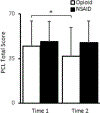Effects of acute pain medications on posttraumatic stress symptoms in early aftermath of trauma
- PMID: 35503040
- PMCID: PMC9357097
- DOI: 10.1097/YIC.0000000000000413
Effects of acute pain medications on posttraumatic stress symptoms in early aftermath of trauma
Abstract
Posttraumatic stress symptoms (PTSS) develop as sequelae from traumatic injuries. Limited studies suggest that using opioids to reduce acute pain immediately after trauma may also reduce subsequent PTSS, but other pain medications rarely have been examined for preventing acute PTSS. The current study examined the effects of commonly used pain medications, opioid and nonsteroidal anti-inflammatory drugs (NSAIDs), on PTSS after acute traumatic injuries. Participants ( n = 71) were categorized into opioid or NSAID group according to their medical records and self-reported medication use. Their PTSS were assessed using posttraumatic stress disorder checklist twice within 2 weeks after trauma. Participants' pain levels reduced from pretreatment to follow-up in both groups, F (1, 55) = 6.696, P = 0.012, partial η 2 = 0.109. Interestingly, a significant interaction between time and medication group on PTSS reached statistical significance, F (1, 69) = 6.014, P = 0.017, partial η 2 = 0.080. Follow-up analyses revealed that this interaction was driven by a significant PTSS reduction only in opioid but not in NSAID group. These findings suggested that pain reduction alone is not sufficient to reduce acute PTSS in the NSAID group, highlighting the need to continue further investigations into the mechanisms by which opioids reduce PTSS in the early posttrauma period.
Copyright © 2022 Wolters Kluwer Health, Inc. All rights reserved.
Conflict of interest statement
Conflicts of Interest: None declared
Figures

References
-
- American Psychiatric Association. (2013). Diagnostic and statistical manual of mental disorders (5th ed.).
-
- Birur B, Moore NC, & Davis LL (2017). An evidence-based review of early intervention and prevention of posttraumatic stress disorder. Community mental health journal, 53(2), 183–201. - PubMed
Publication types
MeSH terms
Substances
Grants and funding
LinkOut - more resources
Full Text Sources
Medical

